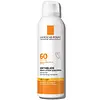What's inside
What's inside
 Key Ingredients
Key Ingredients

 Benefits
Benefits

 Concerns
Concerns

 Ingredients Side-by-side
Ingredients Side-by-side

Butyl Methoxydibenzoylmethane 2.68%
UV AbsorberHomosalate 9.6%
Skin ConditioningEthylhexyl Salicylate 2.88%
UV AbsorberOctocrylene 5.38%
UV AbsorberBenzophenone-3 3.46%
UV AbsorberWater
Skin ConditioningDimethicone
EmollientIsopropyl Lauroyl Sarcosinate
Skin ConditioningGlycerin
HumectantStyrene/Acrylates Copolymer
Isotridecyl Isononanoate
EmollientPolyurethane-35
Caprylyl Methicone
Skin ConditioningOctyldodecanol
EmollientPhenoxyethanol
PreservativePropylene Glycol
HumectantCaprylyl Glycol
EmollientSodium Stearoyl Glutamate
CleansingPolysorbate 61
EmulsifyingGlyceryl Stearate
EmollientPEG-8 Laurate
EmulsifyingDimethiconol
EmollientOctyldodecyl Xyloside
EmulsifyingPEG-12 Dimethicone
Skin ConditioningP-Anisic Acid
MaskingStearyl Alcohol
EmollientDisodium EDTA
Tocopherol
AntioxidantDiethylhexyl Syringylidenemalonate
Skin ProtectingCassia Alata Leaf Extract
AstringentMaltodextrin
AbsorbentButyl Methoxydibenzoylmethane 2.68%, Homosalate 9.6%, Ethylhexyl Salicylate 2.88%, Octocrylene 5.38%, Benzophenone-3 3.46%, Water, Dimethicone, Isopropyl Lauroyl Sarcosinate, Glycerin, Styrene/Acrylates Copolymer, Isotridecyl Isononanoate, Polyurethane-35, Caprylyl Methicone, Octyldodecanol, Phenoxyethanol, Propylene Glycol, Caprylyl Glycol, Sodium Stearoyl Glutamate, Polysorbate 61, Glyceryl Stearate, PEG-8 Laurate, Dimethiconol, Octyldodecyl Xyloside, PEG-12 Dimethicone, P-Anisic Acid, Stearyl Alcohol, Disodium EDTA, Tocopherol, Diethylhexyl Syringylidenemalonate, Cassia Alata Leaf Extract, Maltodextrin
Dibutyl Adipate
EmollientWater
Skin ConditioningDiethylamino Hydroxybenzoyl Hexyl Benzoate
UV FilterDicaprylyl Carbonate
EmollientPropanediol
SolventEthylhexyl Triazone
UV AbsorberMethylpropanediol
SolventBis-Ethylhexyloxyphenol Methoxyphenyl Triazine
Skin ConditioningPhenylbenzimidazole Sulfonic Acid
UV AbsorberArginine
MaskingLupinus Albus Seed Oil
Skin ConditioningBenzotriazolyl Dodecyl P-Cresol
UV AbsorberSodium Chloride
MaskingPalmitoyl Grape Seed Extract
Skin ConditioningGlycerin
HumectantCaprylyl Glycol
EmollientNiacinamide
SmoothingPhenylpropanol
MaskingO-Cymen-5-Ol
AntimicrobialTocopheryl Acetate
AntioxidantPicea Abies Wood Extract
Linalool
PerfumingHelianthus Annuus Seed Oil
EmollientHexyl Cinnamal
PerfumingTocopherol
AntioxidantParfum
MaskingGeraniol
PerfumingCitronellol
PerfumingDibutyl Adipate, Water, Diethylamino Hydroxybenzoyl Hexyl Benzoate, Dicaprylyl Carbonate, Propanediol, Ethylhexyl Triazone, Methylpropanediol, Bis-Ethylhexyloxyphenol Methoxyphenyl Triazine, Phenylbenzimidazole Sulfonic Acid, Arginine, Lupinus Albus Seed Oil, Benzotriazolyl Dodecyl P-Cresol, Sodium Chloride, Palmitoyl Grape Seed Extract, Glycerin, Caprylyl Glycol, Niacinamide, Phenylpropanol, O-Cymen-5-Ol, Tocopheryl Acetate, Picea Abies Wood Extract, Linalool, Helianthus Annuus Seed Oil, Hexyl Cinnamal, Tocopherol, Parfum, Geraniol, Citronellol
 Reviews
Reviews

Ingredients Explained
These ingredients are found in both products.
Ingredients higher up in an ingredient list are typically present in a larger amount.
Caprylyl Glycol is a humectant and emollient, meaning it attracts and preserves moisture.
It is a common ingredient in many products, especially those designed to hydrate skin. The primary benefits are retaining moisture, skin softening, and promoting a healthy skin barrier.
Though Caprylyl Glycol is an alcohol derived from fatty acids, it is not the kind that can dry out skin.
This ingredient is also used as a preservative to extend the life of products. It has slight antimicrobial properties.
Learn more about Caprylyl GlycolGlycerin is already naturally found in your skin. It helps moisturize and protect your skin.
A study from 2016 found glycerin to be more effective as a humectant than AHAs and hyaluronic acid.
As a humectant, it helps the skin stay hydrated by pulling moisture to your skin. The low molecular weight of glycerin allows it to pull moisture into the deeper layers of your skin.
Hydrated skin improves your skin barrier; Your skin barrier helps protect against irritants and bacteria.
Glycerin has also been found to have antimicrobial and antiviral properties. Due to these properties, glycerin is often used in wound and burn treatments.
In cosmetics, glycerin is usually derived from plants such as soybean or palm. However, it can also be sourced from animals, such as tallow or animal fat.
This ingredient is organic, colorless, odorless, and non-toxic.
Glycerin is the name for this ingredient in American English. British English uses Glycerol/Glycerine.
Learn more about GlycerinTocopherol (also known as Vitamin E) is a common antioxidant used to help protect the skin from free-radicals and strengthen the skin barrier. It's also fat soluble - this means our skin is great at absorbing it.
Vitamin E also helps keep your natural skin lipids healthy. Your lipid skin barrier naturally consists of lipids, ceramides, and fatty acids. Vitamin E offers extra protection for your skin’s lipid barrier, keeping your skin healthy and nourished.
Another benefit is a bit of UV protection. Vitamin E helps reduce the damage caused by UVB rays. (It should not replace your sunscreen). Combining it with Vitamin C can decrease sunburned cells and hyperpigmentation after UV exposure.
You might have noticed Vitamin E + C often paired together. This is because it is great at stabilizing Vitamin C. Using the two together helps increase the effectiveness of both ingredients.
There are often claims that Vitamin E can reduce/prevent scarring, but these claims haven't been confirmed by scientific research.
Learn more about TocopherolWater. It's the most common cosmetic ingredient of all. You'll usually see it at the top of ingredient lists, meaning that it makes up the largest part of the product.
So why is it so popular? Water most often acts as a solvent - this means that it helps dissolve other ingredients into the formulation.
You'll also recognize water as that liquid we all need to stay alive. If you see this, drink a glass of water. Stay hydrated!
Learn more about Water